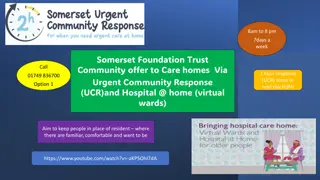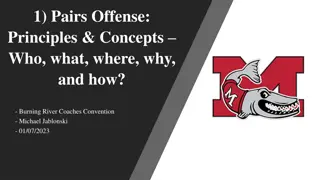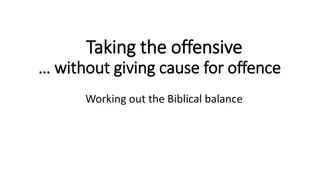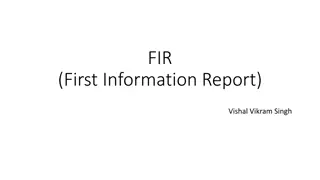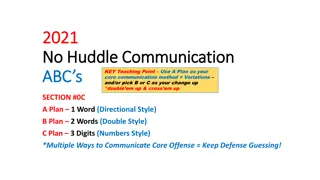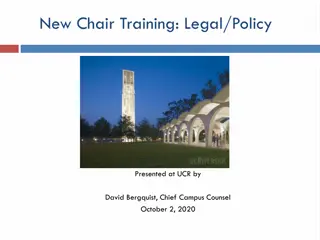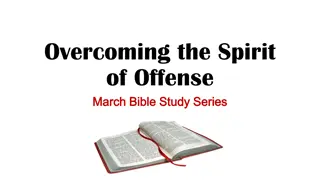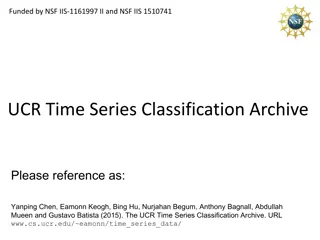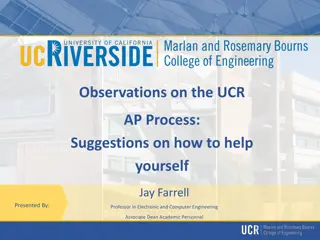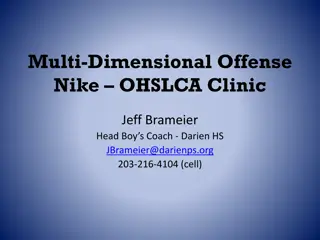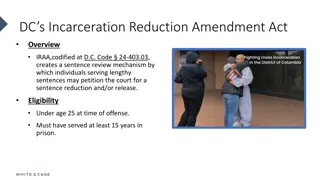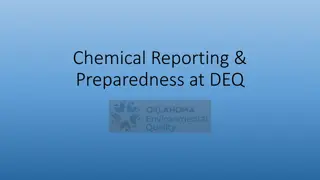Understanding UCR Offense Classification and Reporting
Explore the process of classifying and scoring offenses in the UCR program, categorizing crimes known to law enforcement according to defined criteria. Learn about the hierarchy rule, types of crimes, and how criminal homicides are classified. Proper classification ensures consistency and accuracy in recording crimes for legal reporting purposes.
Download Presentation

Please find below an Image/Link to download the presentation.
The content on the website is provided AS IS for your information and personal use only. It may not be sold, licensed, or shared on other websites without obtaining consent from the author. Download presentation by click this link. If you encounter any issues during the download, it is possible that the publisher has removed the file from their server.
E N D
Presentation Transcript
Classifying and Scoring Part I Offenses in UCR Categorizing Offenses Known to Law Enforcement according to UCR Program Offense Definitions
Classifying Offenses Determining the proper crime categories in which to report offenses in the UCR Program Classifying ensures laws are consistently and uniformly recorded in UCR All applicable NYS Laws assigned a UCR Offense Code Resources for Classifying NYS Laws NYS Coded Law File Downloads for local Records Management Systems UCR Law Section Reference Table UCR offense classification by NYS law UCR Cross Reference Table NYS law by UCR offenses classification
Scoring Offenses Counting the number of offenses after they have been classified Score attempts to commit a crime as though the crime was completed Exception to this applies to attempts to murder when the victim does not die should be scored as aggravated assaults
Types of Crime Crimes Against Persons One Offense counted for each victim (e.g. Murder, Rape, Aggravated Assault) Crimes Against Property One Offense counted for each distinct operation or attempt (e.g. Robbery, Burglary, Larceny-Theft, Arson)* *For Motor Vehicle Theft one offense is counted per stolen vehicle or for each attempt to steal a motor vehicle
The Hierarchy Rule When a crime incident involves more than one offense, only the highest ranking offense is counted All other offenses in the incident are ignored for crime reporting purposes Hierarchy Rule Exceptions: Motor Vehicle Theft and Arson
Criminal Homicide Murder & Non-Negligent Manslaughter Definition: The willful (non-negligent) killing of one human being by another. Deaths caused by injuries sustained in a fight, argument, assault or commission of a crime (except DWI) = Murder Example: PL 125.25 sub 2 - Murder: Depraved Indifference Do NOT include suicides, fetal deaths, traffic fatalities, accidental deaths, assaults to murder, and attempts to murder
Criminal Homicide Negligent Manslaughter Definition: The killing of a person through gross negligence. Example: PL 125.11- Aggravated Criminally Negligent Homicide NOT included in Index Crime counts published by NYS and the Federal UCR Program
Rape Expanded Definition Definition: Penetration, no matter how slight, of the vagina or anus with any body part or object; or oral penetration by a sex organ of another person, without the consent of the victim. Incapable of giving consent due to: Mental capacity (temporary or permanent) Physical capacity (temporary or permanent) Age Includes statutory rape Physical Resistance is NOT required to demonstrate lack of consent
Rape (Pre 2013) vs. Rape (2013 Expanded) Rape (Pre 2013) All penal laws previously included under Rape (Forcible). Rape (2013 Expanded) Penal laws not previously included under Rape (Forcible), that are classified under the new Rape definition. See the UCR Cross Reference Table for a complete listing of laws classified under Rape (Pre 2013) and Rape (2013 Expanded)
Rape (Pre 2013) Definition: The carnal knowledge of a female forcibly and against her will Incapable of giving consent due to: Age Mental capacity (temporary or permanent) Physical capacity (temporary or permanent) Does NOT include statutory rape Example: PL 130.30 sub 2 - Rape 2nd: Intercourse with Person Incapable of Consent-Mentally Disable
Rape (Pre 2013) Weapon Subclasses Handgun Other Firearm Other Weapon Fear (No Weapon) Does NOT apply to Rape (2013 Expanded)
Robbery Definition: The taking or the attempting to take anything of value from the care, custody, or control of a person or persons, by force or threat of force or violence and/or by putting the victim in fear. Larceny + Force = Robbery Example: PL 160.10 sub 3 - Robbery 2nd: Motor Vehicle
Robbery - Weapon Subclasses Handgun Weapon designed to be held with one/both hands Other Firearm Long Guns: Rifle or Shotgun Knife or Cutting Instrument Knife, Broken Bottle, Razor, Ice Pick, or Other Cutting/Stabbing Instrument Other Dangerous Weapon Club, Explosives, Acid, Brass Knuckles, Mace, Pepper Spray, or Other Dangerous Weapon etc., Strong Arm Hands, Fists, Feet, etc.
Robbery - Location Subclasses Highway/Street/Alley Gas Station Convenience Store Bank Other Commercial Building Residence Misc.
Aggravated Assault Definition: An unlawful attack by one person upon another for the purpose of inflicting severe or aggravated bodily injury. Usually accompanied by the use of a weapon or by means likely to produce death or great bodily harm. Classify attempted murder as Aggravated Assault Not necessary that injury result from aggravated assault Example: PL 120.14 sub 1 - Menacing-2nd:Weapon
Aggravated Assault - Weapon Subclasses Handgun Other Firearm Knife or Cutting Instrument Other Dangerous Weapon Strong-arm Hands, Fists, Feet, etc.
Aggravated Assault - Location Subclasses Street Public Building Residence Other
Burglary (Breaking or Entering) Definition: The unlawful entry of a structure to commit a theft or a felony (includes intent to commit). Forcible Entry Unlawful Entry No Force Attempted Forcible Entry Example: PL 140.20: Burglary-3rd Degree: Illegal Entry w/Intent to Commit a Crime
Hotel Rule If a number of units under a single manager are burglarized and the offenses are most likely to be reported by the manager rather than individual tenants, the burglary must be reported as a single offense. Examples: hotel rooms, rooms in a flop house, rooms in a youth hostel, and units in a motel
Exception to the Hotel Rule The Hotel Rule does NOT apply to living areas where a tenant is not considered transient. Examples: apartments in an apartment building, college dorm rooms, etc.
Larceny-Theft (Except MV Theft) Definition: The unlawful taking, carrying, leading, or riding away of property from the possession of another. Example: PL 155.25 -Petit Larceny Do NOT include Motor Vehicle Theft
Larceny-Theft Types Pocket Picking Purse Snatching Shoplifting Thefts From Motor Vehicles Theft of Motor Vehicle Parts and Accessories Theft of Bicycles Theft From Coin-Operated Device or Machine All Other
Motor Vehicle Theft Definition: The theft or attempted theft of a motor vehicle. Includes all self-propelled vehicles that run on land and not on rails (cars, trucks, all-terrain vehicles, snowmobiles, etc.) Limited to NYS Penal Laws specific to motor vehicle theft PL 155.30 sub 8: Grand Larceny- 4th:Motor Vehicle Value Exceeds $100 Unauthorized Use (only PL 165.05 sub 1, PL 165.06, PL 165.08)
Motor Vehicle Theft: MV Type Automobiles: sedans, station wagons, coupes, convertibles, SUVs, minivans, taxis Trucks and Busses: pickup trucks, cargo vans, self-propelled motor home Other Vehicles: snowmobiles, motorcycles, motor scooters, trail bikes, mopeds, ATVs, go-carts, mini-bikes, golf carts and motorized wheel chairs
Arson Definition: Any willful or malicious burning or attempt to burn, with or without intent to defraud, a dwelling house, public building, motor vehicle or aircraft, personal property of another. Example: PL 150.05 Arson 4th: Recklessly Damage Building or Motor Vehicle Do NOT include fires of suspicious or unknown origin
Arson Property Types Structural: single occupancy residential, other residential, storage, industrial/manufacturing, other commercial, community/public, all other structures Mobile: motor vehicle, other mobile property (trailers, boats, airplanes. Other: all property not classified as structural or mobile Includes crops, timber, fences, signs, and merchandise stored outside
Cautions in Classifying Arson Establish the point of origin of the fire. Classify arson under subcategory of the point of origin Car set on fire which spreads to adjacent home would be classified under Mobile-Motor Vehicle. When point of origin is undetermined or there are multiple points of origin, report the arson under the category of property with the greatest fire damage. The Hierarchy Rule does NOT apply to Arson
Contact Information/ DCJS Website Resources NYS Division of Criminal Justice Services Crime Reporting Unit 1-800-262-3257 Email: crimereporting@dcjs.ny.gov UCR Reference Materials: www.criminaljustice.ny.gov/crimnet/ojsa/crimereporting/ucr_refmanuals.htm UCR Training Resources: www.criminaljustice.ny.gov/crimnet/ojsa/crimereporting/ucr_training.htm


